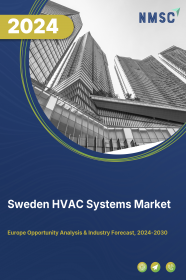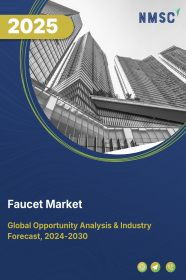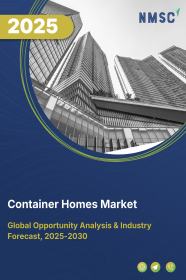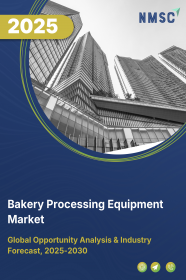
Sweden HVAC Systems Market by Equipment (Cooling Equipment, Heating Equipment, and Ventilation), by Implementation Type (New Construction and Retrofit), and by End User (Residential, Commercial, and Industrial) - Opportunity Analysis and Industry Forecast, 2024– 2030
Industry: Construction & Manufacturing | Publish Date: 13-Nov-2024 | No of Pages: 119 | No. of Tables: 87 | No. of Figures: 52 | Format: PDF | Report Code : CM1938
Market Definition
The Sweden HVAC System Market size was valued at USD 1.39 billion in 2023, and is predicted to reach USD 2.33 billion by 2030, at a CAGR of 7.0% from 2024 to 2030.
HVAC (Heating, Ventilation, and Air Conditioning) refers to the technology and systems used in buildings to regulate indoor environmental conditions such as temperature, humidity, and air quality to ensure comfort and safety for occupants. Heating systems provide warmth during colder months, ventilation systems circulate and replenish indoor air, and air conditioning systems cool and dehumidify indoor air during warmer months.
HVAC systems offer several advantages, including improved occupant comfort and health, increased energy efficiency leading to cost savings, better indoor air quality through filtration and ventilation, precise temperature control for enhanced productivity in commercial settings, and protection of building infrastructure from extreme weather conditions. Additionally, these systems can be designed to meet specific requirements, contributing to sustainability goals by reducing carbon emissions and promoting eco-friendly practices in building operations.
Increasing Energy-Saving Regulations Drives the HVAC System Market
The introduction of residential energy-saving regulations serves as a catalyst for growth in the HVAC system market. These regulations propel market expansion by mandating the adoption of more energy-efficient systems, compelling manufacturers to develop compliant HVAC units.
Consequently, consumers are motivated to invest in energy-efficient HVAC systems to fulfill regulatory obligations and minimize energy expenses. Additionally, these regulations enhance homeowners' awareness of the advantages of energy-efficient HVAC systems, resulting in heightened demand for such products.
This heightened demand stimulates manufacturers to innovate and broaden their product offerings to cater to the burgeoning market demands, thereby intensifying the demand for energy-efficient HVAC systems.
Growing Demand for Improved Indoor and Outdoor Air Quality Drive the HVAC System Market
The burgeoning need for enhanced indoor and outdoor air quality is propelling growth within the HVAC system market. Heightened awareness concerning air quality's significance is prompting both residential and commercial property proprietors to invest in HVAC systems capable of efficiently filtering and purifying indoor air while curtailing outdoor emissions.
Consequently, there exists a surging demand for advanced HVAC systems integrated with contemporary filtration technologies such as HEPA filters and UV-C light sterilization, proficient in eliminating pollutants, allergens, and pathogens from indoor environments. This path is compelling HVAC manufacturers to innovate and introduce novel solutions prioritizing air quality enhancement, thereby catalyzing the expansion of the HVAC system market.
Regulatory Compliance Associated with HVAC Systems Impede the Market Expansion
The growth potential of the HVAC industry encounters a significant barrier in regulatory compliance. This entails adhering to a multitude of laws, regulations, and standards stipulated by governmental bodies and industry organizations, covering various aspects including energy efficiency, emissions, refrigerants, and building codes. Compliance with such regulations necessitates substantial investments in research, development, and technology to ensure alignment with prescribed standards.
However, for smaller enterprises or those with limited resources, navigating this intricate regulatory landscape can be particularly daunting, potentially impeding their market entry or expansion. Furthermore, compliance efforts often divert resources away from innovation and product development, as companies prioritize meeting regulatory requirements over investing in new technologies or enhancing existing ones.
Consequently, regulatory compliance acts as a hindrance to the growth and development of the HVAC market, imposing additional costs and complexities on industry players and limiting their ability to fully exploit market opportunities.
IoT Integration Creates Ample Opportunities for the HVAC System Market
The integration of Internet of Things (IoT) technology introduces a significant market opportunity for the HVAC industry. This integration facilitates remote control capabilities, enhanced energy efficiency, and predictive maintenance solutions. By incorporating IoT devices and sensors into HVAC systems, users can remotely monitor and adjust settings, optimize energy consumption, and proactively address maintenance issues before they escalate.
This augmentation enhances user experience and comfort, reduces energy expenditures, and extends the operational lifespan of HVAC equipment. With mounting demand for buildings that surpass the efficiency of existing infrastructure, the implementation of IoT integration is anticipated to generate ample opportunities within the HVAC system market.
Competitive Landscape
The market players operating in the Sweden HVAC System market include Midea Group Co Ltd, Daikin Industries Ltd., Gree Electric Appliances Inc., Johnson Controls International Plc., Carrier Global Corporation, Samsung Electronics Co., Ltd., Trane Technologies Plc., LG Electronics Inc., Panasonic Holdings Corporation, Lennox International Inc. and others.
Sweden HVAC System Market Key Segments
By Equipment
-
Cooling Equipment
-
Unitary Air Conditioners
-
Variable Refrigerant Flow Systems (VRF)
-
Chillers
-
Room Air Conditioners
-
Coolers
-
Cooling Towers
-
-
Heating Equipment
-
Heat Pumps
-
Furnaces
-
Unitary Heaters
-
Boilers
-
-
Ventilation
-
Air-handling Units (AHUs)
-
Air Filtration Systems
-
Ventilation Fans
-
HRVs & ERVs
-
Air Purification Systems
-
Others
-
By Implementation Type
-
New Construction
-
Retrofit
By End User
-
Residential
-
Commercial
-
Industrial
REPORT SCOPE AND SEGMENTATION:
|
Parameters |
Details |
|
Market Size in 2023 |
USD 1.39 Billion |
|
Revenue Forecast in 2030 |
USD 2.33 Billion |
|
Growth Rate |
CAGR of 7.0% from 2024 to 2030 |
|
Analysis Period |
2023–2030 |
|
Base Year Considered |
2023 |
|
Forecast Period |
2024–2030 |
|
Market Size Estimation |
Billion (USD) |
|
Growth Factors |
|
|
Companies Profiled |
10 |
|
Market Share |
Available for 10 companies |
|
Customization Scope |
Free customization (equivalent up to 80 working hours of analysts) after purchase. Addition or alteration to country, regional, and segment scope. |
|
Pricing and Purchase Options |
Avail customized purchase options to meet your exact research needs. |
KEY PLAYERS
-
Midea Group Co Ltd.
-
Daikin Industries Ltd.
-
Gree Electric Appliances Inc.
-
Johnson Controls International Plc.
-
Carrier Global Corporation
-
Samsung Electronics Co., Ltd.
-
Trane Technologies Plc.
-
LG Electronics Inc.
-
Panasonic Holdings Corporation
-
Lennox International Inc.

















 Speak to Our Analyst
Speak to Our Analyst





















